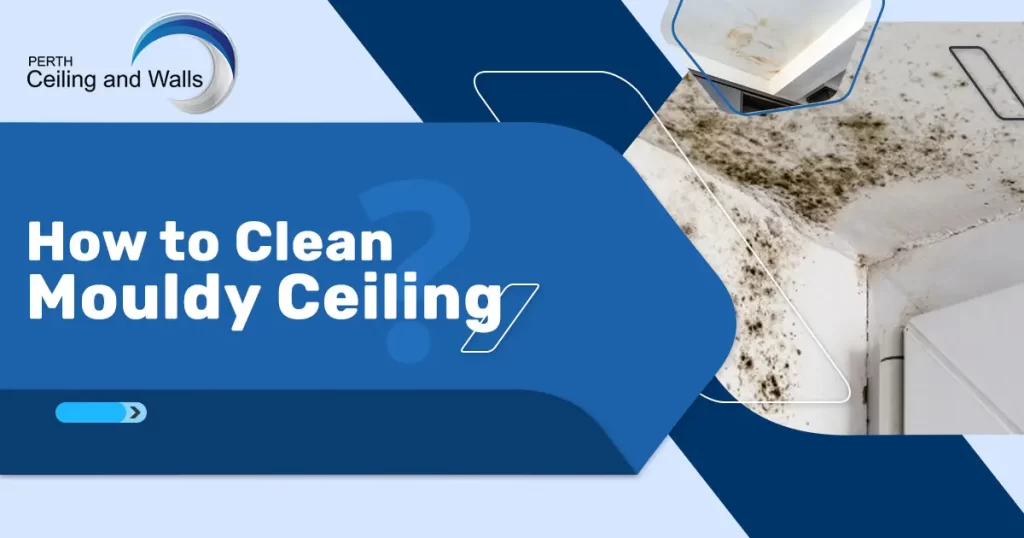
Mould on the ceiling is a common problem for many homeowners. It can appear as unsightly spots and spread quickly if not addressed. Besides being ugly, mould can cause health issues for you and your family. Knowing how to handle it is crucial.
Mould is a type of fungus that thrives in damp environments, both inside and outside your home. While it plays a beneficial role outdoors by breaking down organic matter, indoor mould can pose serious health risks and damage to your property, especially your ceiling.
It’s important to know how to clean mould off a ceiling to keep your home safe and healthy.
What Causes Mould in Ceiling?
Maybe you’re wondering, “Why is there mould on my ceiling?” Let us explain why this common issue occurs.
Mould on ceilings is usually caused by the presence of moisture. Tiny spores from outdoor moulds can enter your home through doors, windows, heating and air conditioning vents, or even on your clothing, shoes, and pets. Once these spores find a moist environment, they start to grow.
Older homes with excessive humidity and poorly insulated ceilings are more prone to mould growth. Plumbing and roof leaks are often major contributors to mould growth on ceilings. Water damage from leaks might just be a small part of a larger problem.
Health Risk of Mouldy Ceiling
Having mould in your home might not always make you sick, but it can cause certain health issues. Touching or inhaling mould spores can lead to allergy-like symptoms. These include a runny nose, congestion, eye irritation, sneezing, coughing, a sore throat, skin rash, headache, lung irritation, and wheezing.
Most people breathe in mould spores without any problems. However, if you have allergies, asthma, or other breathing issues, you might be more sensitive to mould. People with weakened immune systems are also at higher risk.

How to Clean Mouldy Ceiling
Cleaning mould off your ceiling can be done using various methods. Here are the most effective ones:
1. Using Dishwashing Detergent
- What You’ll Need: Dishwashing detergent, two microfibre cloths, water, thyme or oregano essential oils (optional).
- Instructions:
- Mix dishwashing detergent with warm water.
- Optionally, add essential oils like oregano or thyme to enhance the cleaning effect.
- Dip a microfibre cloth into the solution and wipe up the ceiling surface. Use each side only once to avoid spreading the mould.
- Discard the used clothes to prevent cross-contamination.
2. Using Specialist Mould Spray
- What You’ll Need: A mould spray or a mould remover foam spray.
- Instructions:
- Spray the mouldy ceiling area from 3-5cm away.
- Wait for 30 minutes.
- Wipe off with a wet sponge.
3. Using Household Bleach
- What You’ll Need: Clear bleach, water, gloves, a cloth or a spray bottle.
- Instructions:
- Mix 250ml of bleach with water in a bucket.
- Apply the solution to the mould with a cloth or spray bottle.
- Leave it for 15 minutes, ensuring the room is well-ventilated.
- Wipe clean and repeat if necessary.
4. Using Vinegar
- What You’ll Need: White vinegar, water, a spray bottle, and a scrub brush.
- Instructions:
- Fill a spray bottle with undiluted white vinegar.
- Spray the mouldy areas and let it sit for an hour.
- Scrub the mould with warm water and a brush.
- Wipe clean with a cloth.
5. Using Clove Oil
- What You’ll Need: Clove oil, white vinegar, water, spray bottle.
- Instructions:
- Mix 1/4 teaspoon of clove oil with a litre of water.
- Spray the solution on the mould and leave it for 24 hours.
- Wipe down with a mixture of three parts vinegar and two parts water.
- Let the area air dry.
Important Tips:
- Always wear protective gear such as gloves and a mask to avoid inhaling mould spores.
- Ensure the room is well-ventilated during and after cleaning.
- Do not simply paint over mould; it will continue to grow underneath.
Using these methods, you can effectively clean mould from your ceiling and prevent it from returning.
Signs of Mould in Ceiling
Mould on the ceiling can sometimes be difficult to detect, but there are several warning signs to look out for.
- Visible Mould: Look for black spots, dark green, grey, or brown rings or spots on ceilings, walls, and furniture.
- Musty Odour: A strong, musty smell similar to an old book or damp basement is a common sign. If the smell is present but the mould isn’t visible, consider a professional inspection.
- Condensation: Fog or beads of water on windows and glass doors, and rusty metal fittings like curtain rods and window frames, indicate high humidity.
- Water Damage: Bubbles, cracks, or peeling in wallpaper or paint, and bulging or warped ceilings and walls, are signs of potential mould growth. Discolouration or water stains on ceilings, walls, or floors also indicate high humidity or plumbing leaks. Sagging ceilings can sometimes be a sign that water damage has occurred.
- Health Symptoms: Allergy-like symptoms such as a runny nose, congestion, eye irritation, coughing, or wheezing can be caused by mould. Asthma or allergy sufferers may notice worsening symptoms.

What if the Mould Damage is Too Severe?
If the mould damage on your ceiling is too severe to clean, you have a few options:
Mould Remediation
When mould damage is extensive, mould remediation experts have the tools and knowledge to remove mould safely and thoroughly. They can also identify and fix the underlying causes of mould growth, ensuring it doesn’t return.
Ceiling Replacement
In cases where the mould has deeply penetrated the ceiling, replacing the entire ceiling might be necessary. A reliable ceiling contractor will remove the damaged sections and install new materials. They will also use anti-mould paints and coatings to prevent future growth.
If a full replacement isn’t required, water-damaged ceiling repair is another option. This involves removing and replacing only the affected areas. It’s a less extensive process but still effective in addressing severe mould issues.
Reviewed by
Aaron Kumar
Aaron Jefferson Kumar. The owner and operator of Perth Ceiling and Walls. With hands-on expertise in plasterboard ceiling and wall repairs and installations, Aaron takes pride in ensuring every project meets the highest standards of quality and craftsmanship. His direct involvement in both the business and the fieldwork positions him as a trusted person on all things related to ceiling and wall solutions.
